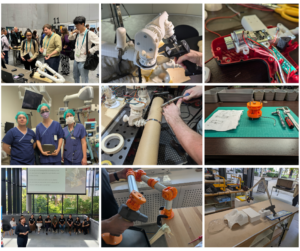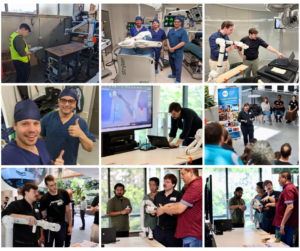Human Robotic Interaction prototyping toolkit
Start: February 2023
Expected end date: August 2026
James Dwyer is a PhD researcher in Program 2 at the Australian Cobotics Centre, working on Project 2.2: Human Robotic Interaction prototyping toolkit. His research focuses on developing a prototyping toolkit that facilitates co-design approaches for human-robot collaboration (HRC) in manufacturing and surgical contexts. As industries increasingly adopt collaborative robots (cobots), James’ work addresses the critical need to balance technological innovation with human-centered design principles, ensuring that these systems are intuitive, effective, and meet the real-world needs of end-users.
With a background in Industrial Design and Psychology, James graduated with an MPhil from the BMW Group + QUT Design Academy where he explored advances in human-robot interactions. His professional experience includes tutoring Industrial Design units focused on tangible interactions and working as a Research Assistant on various QUT Design Lab projects related to transport and health. James brings valuable expertise in prototyping and coding, having led high-profile projects including the HEAL project and serving as creative team lead for the ARS Electronica Futurelab, which was a finalist in the 2018 IxDA Awards.
James’ current research involves collaborating with industry partners Stryker and Cook Medical to ground his work in practical, real-world scenarios. By investigating how prototyping methods can be evolved to support collaborative design processes, he aims to bridge the gap between technical innovation and human needs in cobot implementation. His work contributes significantly to advancing methodologies for human-robot collaboration research and design, with potential applications extending beyond manufacturing and surgical contexts to influence cobot adoption across various industries.
Expected or Achieved Outcomes
- Developed the “kinematic puppet,” a novel, cost-effective, modular tangible interface that facilitates embodied exploration of robotic movements through roleplaying and Wizard-of-Oz prototyping, enabling non-technical stakeholders to engage in human-robot collaboration design.
- Created a bridge between physical and virtual prototyping by implementing a digital twin system that mirrors the kinematic puppet’s movements in real-time, allowing for rapid exploration of complex robot interactions in simulated environments.
- Working to establish a methodology for early-stage HRC prototyping that reduces technical barriers and supports more human-centered design approaches.
- Working with industry partners Stryker and Cook Medical to validate and refine the HRC prototyping toolkit in real-world scenarios.
- Aim to develop a comprehensive HRC prototyping toolkit that integrates both tangible and virtual prototyping methods, providing designers and stakeholders with accessible tools to explore collaborative robot implementations.
Supervisory Team
- Principal Supervisor: Associate Professor Jared Donovan
- Associate Supervisors: Professor Markus Rittenbruch, Dr Valeria Macalupu, Associate Professor Rafael Gomez
Publications
First Author
- TBC
Other Publications
- TBC
Conference Demonstrations
- 2025 HRI conference (March 4-6, 2025 – Melbourne, Australia) – Paper Title: What Would Jim Henson Do? Roleplaying Human-Robot Collaborations Through Puppeteering
What Would Jim Henson Do? Roleplaying Human-Robot Collaborations Through PuppeteeringHRI ’25: Proceedings of the 2025 ACM/IEEE International Conference on Human-Robot Interaction – Pages 1773 – 1775https://dl.acm.org/doi/10.5555/3721488.3721764


Associated Researchers

